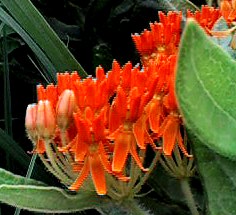
A. Butterfly weed (Asclepias tuberosa) is easy to grow from seed. For the quickest flowers, start seed in late August. Fresh seed requires a period of cool, damp stratification. Provide this by placing the seed in a bag of moist peat moss and keeping it in the refrigerator for ten to twelve weeks. Older seed will not require this cold period to break its dormancy. Direct seed butterfly weed outside, or grow the seedlings in a nursery bed until the plants have five or six leaves, at which time it should be moved to its permanent location. Give the seed proper attention while it is germinating; though the mature plants will tolerate somewhat dry soils, the seedlings need to be kept moist until established. Fall-grown plants will provide moderate bloom the following year, with improved bloom in successive seasons.
If you prefer, you can start butterfly weed in the spring. Follow the same procedures as for fall sowing. Butterfly weed requires winter cold to bloom, so spring-sown plants will not bloom their first summer. However, the long summer days will allow the seedlings to grow into large plants which will produce many blooms the following year.
![]() |
|
Asclepias Tuberosa: “Butterfly Milkweed” This is a favorite in many gardens for it’s lovely flower and the butterflies it attracts, it is always blooming.
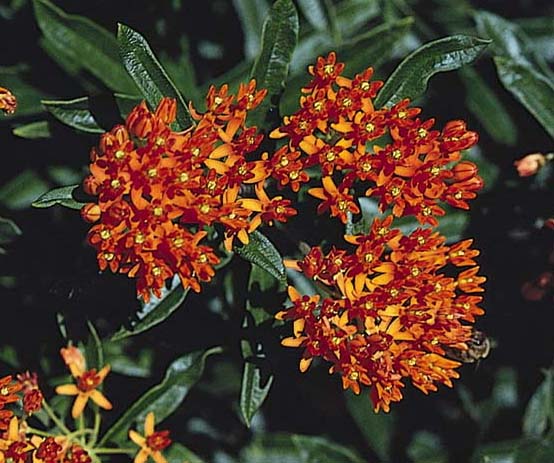
Butterfly Weed
Asclepias tuberosa (Asclepiadaceae)
An extremely hardy, long-lived perennial native to North America. The magnificent bright orange flowers are concentrated in compact clusters at the top of branching stems. The flowers produce a large quantity of nectar which attracts butterflies throughout the growing season. Requires a very well-drained sandy or gravelly soil in full sun. Butterfly Weed may take up to two years to become established from seed.
Average planting success with this species:
50%
Height: 12-24 inches
Germination: 30-90 days
Optimum soil temperature for germination:
65-75F
Sowing depth: 1/16"
Blooming period: June-September
Average seeds per pound: 87,000
Seeding rate: 10 lbs. per acre
Suggested use: Rock gardens, roadsides, mass plantings, borders.
Miscellaneous: Produces a very deep taproot making transplanting difficult. The stem, when broken, does not produce the milky white sap characteristic of this plant family. Once established is very dependable.
![]()
Note: Also called Indian nosy.Food: A member of the Milkweed family, so most parts of the plant contain toxins. A crude sugar is produced from the flowers.Medicine: Poultices for sores were made from the powdered root. A tea from the root encourages sweating. A tea was also made to induce vomiting during certain rituals.
![]()
Asclepias tuberosa
Asclepias tuberosa--Butterfly Weed
Butterfly weed is a member of the milkweed family. The plants grow to two feet tall and flower from July to September. The flower colors are orange, red and yellow. The plant will not flower freely until well established. The best sites have exposure to sun or partial shade and almost any soil. The plant tolerates dry soil but not heavy soil. Once established do not disturb butterfly weed unnecessarily. Butterfly weed is slow to start growth in the spring. Mark its location to prevent damage to easily injured dormant crowns. A taproot makes transplanting difficult.
Propagation is by seed or division in the spring. The seed germinates in 3 to 4 weeks at 70 to 75 degrees. Plants may be planted in a cold frame in spring or fall. Fresh seed may need chilling.
![]()
 |
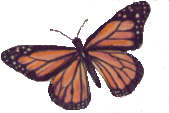 |
BUTTERFLY WEED
This little fellow has pretty light green and grey stripes on a cream colored body and while I'm not much for messing around with any kind of creepy crawlies, this animal has real potential. If you guard him and allow him a few tidbits from your garden, he will evolve into a beautiful Monarch butterfly ! He loves milkweed and some of the milk weeds make lovely additions to the garden.
I particularly like the Butterfly milk weed (Asclepias tuberosa). It grows wild in some parts of Texas, but a cultivar can be found in the various seed catalogs. It has brilliantly orange bloom clusters atop stalks covered with about 1 1/2 inch long, slender grayish green alternate leaves. The sap is not as milky as some milk-weeds, being a bit thin and runny.There are not many around in my immediate area that I have acceses to except for 3 or 4 oplants in a vacant lot on the other side of the hill. There was only one plant there last year. Looks like more this year. I will have to wait. I don't want to mess them up.
The mature plant contains a chemical, 'Asclepian' which is a meat tenderizer. You put a small sprig in with the stewing meat to cook and tenderize it then remove it before serving.
Native Americans, so I am told, used the fluff from the seeds added to the dried inner bark of cedars (1/3 fluff and 2/3 cedar) to make fire bow tinder.
LIKE POKE WEED, ALL PARTS OF THE PLANT ARE TOXIC UNLESS PAR-BOILED FIRST. It blooms in the summer, but parts of the plant are usable spring and summer. All parts are edible: roots, flower buds, flowers, and young seed pods. The plant is high in ascorbic acid. DO NOT EAT ANY PART OF THE PLANT RAW. Like the South's POKE WEED, the flowers, buds, and pods must be boiled for 12-15 minutes, drained then boiled again. Do this 2 or 3 times. The pods should be picked before they become too elastic. The roots should be boiled 30 minutes, pouring off the water several times. Put a pinch or two of baking soda in the water while boiling.
The flowers can be dipped in boiling water for about 1 minute then dipped in pancake batter and fried like fritters and eaten moderately.
![]()
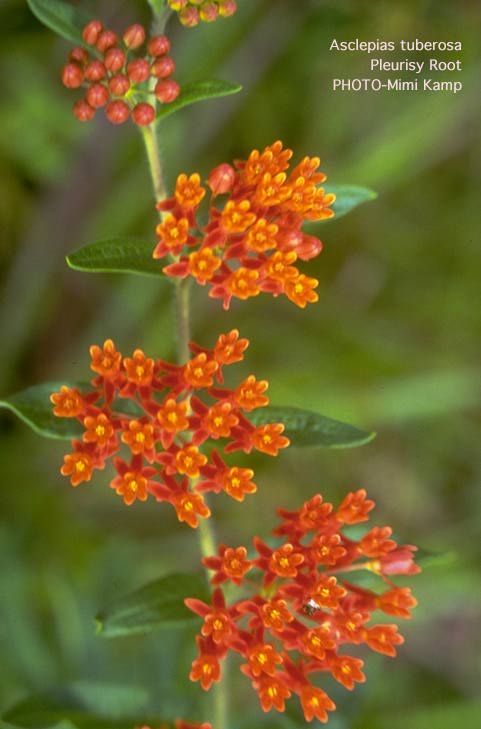
![]()
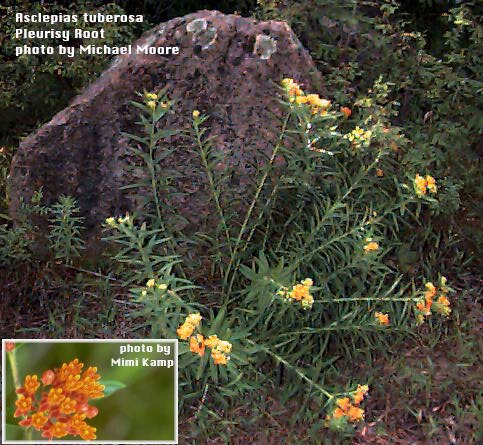
![]()
Asclepias tuberosa . . BUTTERFLY WEED
1 to 3 ft. . . Sun to lt. shade . . Avg. soil, well drained . . Native . . Bright orange flowers attract butterflies. Blooms June - July. Loose, well drained soil is best. Very long lived, but may take a year to reach blooming size. Does not like to be moved. . . The favorite of the native milkweeds. Long the target of collectors, it fights back by refusing to transplant. The part collected dies and the pieces of tap root left deep in the ground sprout anew. Butterfly Weed will tolerate heat, poor soil and dry conditions, making it a good choice for those places where nothing seems to grow well. . . The young shoots were used as a pot herb by the Indians. . . The root of Butterfly Weed has been used as a wound dressing, as a treatment for fevers, bronchitis, rheumatism, colic, pleurisy and "the hysteric passion" . . #1013 . . Zones 3 to 10 . . Quart pot . .
![]()
Asclepias tuberosa . . BUTTERFLY WEED
1 to 3 ft. . . Sun to lt. shade . . Avg. soil, well drained . . Native . . Bright orange flowers attract butterflies. Blooms June - July. Loose, well drained soil is best. Very long lived, but may take a year to reach blooming size. Does not like to be moved. . . The favorite of the native milkweeds. Long the target of collectors, it fights back by refusing to transplant. The part collected dies and the pieces of tap root left deep in the ground sprout anew. Butterfly Weed will tolerate heat, poor soil and dry conditions, making it a good choice for those places where nothing seems to grow well. . . The young shoots were used as a pot herb by the Indians. . . The root of Butterfly Weed has been used as a wound dressing, as a treatment for fevers, bronchitis, rheumatism, colic, pleurisy and "the hysteric passion" #1013 . .
Zones 3 to 10
![]()
![]()
Back to Plants
 Wildflower
Seed For Sale
Wildflower
Seed For Sale